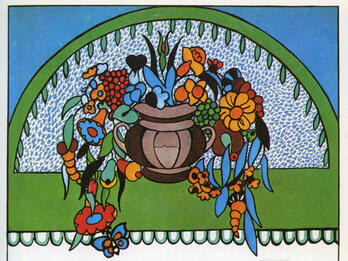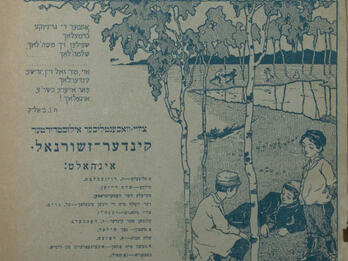Children, Onward! (Yeladim, lekhu!)
Parade Procedure
All of the children stand in pairs in a row, along the length of the room, in the middle. The child on the right holds a white flag in their right hand, and the one on the left holds a blue flag in their left hand. The tallest pair stand at the front, holding hands and raising them—in the form of a gateway—and these two remain standing in their place throughout the time of the procession. With the start of the song, the children all pass through the open gate: the child with the white flag standing in front of the line turns right from the gate and the rest of the children with white flags follow behind, while the child holding the blue flag standing in front of the line with the blue flag turns left [and is similarly followed]. In this manner the pairs split into two straight lines turning from the gate in opposite directions and move, while singing, to the far end of the room, where the two leading children meet for the first time, hold hands with each other, and move on toward the gate; behind them the rest of the children meet and each one holding a white flag offers a hand to their partner holding the blue flag, and all the pairs move to the gate following the two leading children who walk in front of them. Arriving at the gate, they separate once again and meet at the other end of the room as explained above. And during this they repeat the song several times. The [female] kindergarten teacher must ensure that all the children are marching to the melodic beat, and each one walks in step with their partner. When the children become accustomed to the white and blue flags, the teacher gives them red and green flags, yellow or black, etc. and thus the children learn to differentiate between all the colors. Instead of flags it is possible to use knots, balls, etc.
Credits
Ye?iel Halperin, “Yeladim, Lekhu!” [Children, Onward!], from Zmirot: Shirei-‘am veshirei-mis?ak bishvil gane-yeladim ‘ivrim, vol. 2 (Odessa: Moriah, 1912), pp. 19–20.
Published in: The Posen Library of Jewish Culture and Civilization, vol. 7.




